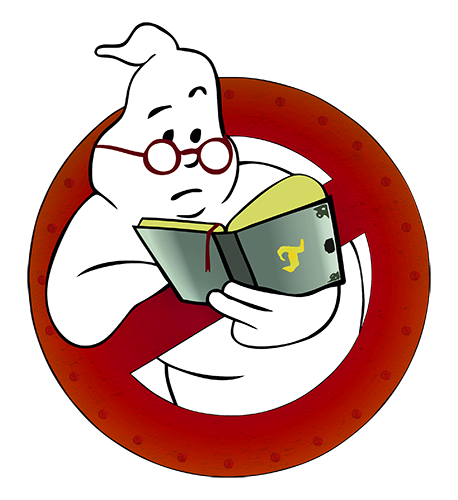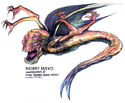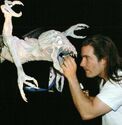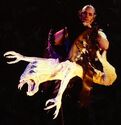The Theatre Ghost appeared out of a cinema, scaring a lot of people. It appeared during a ghost outbreak caused by Vigo's use of the Psychomagnotheric Slime to come back to life.
History[]
On December 31, 1989, the Theatre Ghost manifested at a special New Year's Midnite Show screening of the movie, "Cannibal Girls" at Movieland Theater. It scared dozens of movie goers outside and chased them outside.
Description[]
The Theatre Ghost resembled a ghoulish creature with six yellow eyes without pupils, demonic wings, two forearms in the same elbow joint on both arms, and four four-fingered claws.
Behind the Scenes[]
The Theatre Ghost was created by Rick Lazzarini of The Creature Shop in Van Nuys based on a drawing by Henry Mayo. The head was human-size and sculpted by John Blake and the body was made by Dan Frye. Since the ghost was added late into production, the crew had three weeks to make the puppet. Lazzarini employed the 'Facial Waldo' interactive device, a cap and vest system worn by an external operator. When the operator moved his brow, cheek, lips and jaw, sensors would send signals to the servos inside the puppet and mimic the movement done. If the operator moved his brow, all six on the ghost would move. The operator was free to puppeteer the wings. Three additional puppeteers operated the tail and four arms. The puppet was shot against black so the puppeteers all wore black beekeeper-like suits and mesh face screens. The real difficulty was operating the puppet at 48 frames a second in order to portray smooth movements.[1][2][3][4][5]
Trivia[]
- In the September 29, 1988 draft, on page 80, St. Mark's Playhouse is host to an All Night New Year's Eve 3-D Horror Show. Moviegoers mistake the ghosts for being part of the movie and applaud. In the movie itself, Movieland Theatre and the ghost takes the place of this scene.
- St. Mark's Playhouse was a discarded idea from drafts of the first movie.
- The scene with this ghost is similar to Subway Ghost scene from the first movie.
- "Cannibal Girls" is a movie directed by Ivan Reitman, director of the Ghostbusters movies. "Cannibal Girls" starred Eugene Levy, who appeared in a deleted scene as Louis Tully's cousin, Sherman Tully, who helps get the Ghostbusters discharged from Parkview Psychiatric Hospital.
- The Theatre Ghost makes cameo appearances in Lego Dimensions, both in the main story and in the Ghostbusters Level Pack.
Appearances[]
References[]
- ↑ Eisenberg, Adam (November 1989). Ghostbusters Revisited, Cinefex magazine #40, page 30. Cinefex, USA. Line reads: "More elaborate means were used to produce two monsters--one observed coming out of a movie theater and a second terrorizing people in Washington Square. The first--photographed at Apogee--was created by Rick Lazzarini of The Creature Shop in Van Nuys."
- ↑ Eisenberg, Adam (November 1989). Ghostbusters Revisited, Cinefex magazine #40, page 30. Cinefex, USA. Rick Lazzarini says: "The theater ghost was based on a drawing by Henry Mayo. It had six eyes, four arms, two wings and a forked tail. The head was nearly human-size and sculpted by John Blake, while the body was made by Dan Frye. I worked on the mechanics. Since the theater ghost was added late to the film, we had only three weeks to build and shoot the puppet."
- ↑ Eisenberg, Adam (November 1989). Ghostbusters Revisited, Cinefex magazine #40, page 30. Cinefex, USA. Rick Lazzarini says: "The Facial Waldo is a cop and vest system worn by an external operator. Sensors are attached to the operator's face--on the brows, cheeks, lips and jaw--and these sensors link up to Ziff cards in the vest. Ziff cards were invented by Stuart Ziff to enable radio control-type servos to be operated by direct wire--thus eliminating a noisy radio link. In effect, they fool the serco into thinking it is getting a command from a radio receiver. On Ghostbusters II, the Ziff cards received information from the sensors on my face and head and then sent signals to servos inside the creature. When I moved my eyebrow or any part of my face, the theater ghost did the same thing; and if I moved my head left or right, the puppet did likewise. Since the theater ghost had six eyes, it therefore had six eyebrows so that when I moved my brow, all six moved on the creature. This kept my hands free to puppeteer the wings, and it also allows for a much more natural performance."
- ↑ Eisenberg, Adam (November 1989). Ghostbusters Revisited, Cinefex magazine #40, page 30. Cinefex, USA. Line reads: "Three additional puppeteers wore black beekeeper-style suits with black mesh face screens so they could see without being visible on film. In a single shot, the creature flies out of the theater, leers at the fleeing crowd on the street and then rushes at the camera. Even with the Facial Waldo, puppeteering the creature was still very difficult because of the number of appendages involved and the short length of the shot."
- ↑ Eisenberg, Adam (November 1989). Ghostbusters Revisited, Cinefex magazine #40, page 30. Cinefex, USA. Sam Nicholson says: "The real difficulty came after we had rehearsed everything at half-speed to get the moves down and then realized that forty-eight frames per second was necessary to make the movements look smooth. This meant that the puppeteers had to do the moves two or three times faster--and all within about two-and-a-half seconds. Also, to finish with the creature's mouth just about covering the camera, we had to shoot the whole thing in reverse. That put a real strain on both the camera crew and the puppeteers." To create a glowing effect, the creature's eyes were coated with front-projection material. "We put a ring light on the lens and then dialed up the intensity as we got closer to the creature so it would really look like he was coming at us. Having the eyes lit not only helped increase the illusion of depth, but it also made the creature seem more alive."









